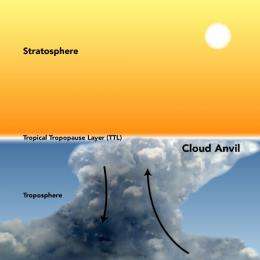Forging cloud anvils: Pollution particles enlarge and extend the lifetime of storm clouds

Tiny particles of pollutants in the lower atmosphere have a striking effect on cloud anvils, which are created by thunderstorms. That's the conclusion of a team of atmospheric scientists at Pacific Northwest National Laboratory. They conducted simulations of these storm clouds under two contrasting atmospheric conditions: humid and clean, and dry and polluted. They found that increasing the concentrations of those tiny particles increases anvil cloud size and lifetime in both cases.
Our insight into the impact of human activity on climate change may hinge on understanding the effects of aerosols, those tiny unseen atmospheric particles that come from pollution. How aerosols contribute to the formation of clouds will further that understanding. Until now, how aerosols affect cloud anvils has not been well understood.
In the atmosphere between the troposphere and the stratosphere is a thin layer called the tropical tropopause layer (TTL). Rising air from storm clouds expands when it meets this layer to form cloud anvils. Satellite data suggest that aerosol particles from forest fires might prolong the life of cloud anvils. Pollution might also increase water vapor in the TTL because cloud anvil properties are changed.

To explore how aerosol particles affect cloud anvils and water vapor in the TTL, scientists at PNNL conducted simulations of thunderstorms forming in the tropics around Darwin, Australia. They performed sensitivity studies for two deep convective clouds, which develop in contrasting conditions: one started with humid and clean conditions, the other dry and polluted. Scientists found that in both cases, aerosols enlarge the cloud anvil size and lifetime. This finding could not be explained by convection, which is enhanced by aerosols in the humid case but suppressed in the dry case.
By looking at the microphysics of both cloud cases, scientists found that the increase of aerosols, especially aerosols at the lower levels, induced more ice particles along with a decrease in their individual sizes, which helped cloud anvils spread in the TTL. Aerosols from the pollution created numerous cloud droplet particles. The more particles there are, the smaller each droplet's size becomes. The smaller droplets don't fall out as rain. Instead, they are pushed upwards, where temperatures freeze them into ice particles. As a result, more but smaller ice particles form. Because smaller ice particles fall slowly, they stay longer in the layer, which contains strong horizontal winds and, therefore, spread farther than larger ice particles. As pollution increases the anvil size, it also increases the water vapor in the TTL clean air because of the moistening effect of clouds.
In addition, aerosols in the lower troposphere modified convection and the upper-level cloud properties. Lastly, the study showed the effects that ice nuclei and cloud condensation nuclei—which are parts of aerosol particles in the lower and middle troposphere—have on upper-level clouds depend on the humidity, resolving some contradictory results from past studies.
Researchers will be using a similar approach to study aerosol effects in more complicated, large-scale weather systems, such as the Monsoon system in the Australia region. In addition, they will investigate how those effects are sensitive to different ice nucleation parameterizations.
More information: Fan J, J Comstock, and M Ovchinnikov. 2010. "The Cloud Condensation Nuclei and Ice Nuclei Effects on Tropical Anvil Characteristics and Water Vapor of the Tropical Tropopause Layer." Environmental Research Letters: 5 (October-December 2010) 044005. doi:10.1088/1748-9326/5/4/044005
Provided by Pacific Northwest National Laboratory

















